Axminster SIEG C1 Micro Lathe Mk2 User manual
- Category
- Lathes
- Type
- User manual
This manual is also suitable for

2004
600882
SIEG C1 Micro
Lathe Mk2
Axminster Reference No: C1
Mk 2 Part No: 600882
User Manual
WHITE
AXMINSTER
W
www.axminster.co.uk

Page No.
Index of Contents
02
The undersigned, Ole Stilling authorised
by Shanghai SIEG Machinery Co., Ltd.
No.555 Caofeng Rd., South to No.17
Bridge of Caoan Rd.,Shanghai
declares that this product:
Micro Lathe
C1
manufactured by Shanghai SIEG Machinery Co.
is in compliance with the following standards or
standardisation documents
EN55014-1: 2000, EN55014-2: 1997
EN61000-3-2: 2000, EN61000-3-3: 1995
in accordance with Council Directives
(89/336/EEC amended by 93/68/EEC)
Declaration of Conformity
Index of Contents.............................................................................................................................................. 2
Declaration of Conformity
………….………........……..…………...................................................................2
What’s in the Box………….………........……..………….....................................................................................3
General Instructions for 230v Machines......................................................................................... 4
Initial Assembly and Testing............................................................................................................5
Testing........................................................................................................................................... 5-6
Specifications
….………........……..…………...................................................................................................7
Definitions..........................................................................................................................................................7
Parts Identification and Description................................................................................................ 8
Machine Illustration of the Micro-Lathe...........................................................................................9
Parts Identification and Description (Continued)......................................................................... 10
Machine Illustration of the Micro-Lathe (Continued).................................................................... 11
Parts Identification and Description (Continued)......................................................................... 12
Machine Illustration of the Micro-Lathe(Continued)................................................................13-14
Settings and adjustments..............................................................................................................15
Maintenance..............................................................................................................................16-17
Oiling Points................................................................................................................................... 17
Illustrated Parts Breakdown for the Micro-Lathe (Part 1)........................................................18-19
Illustrated Parts Catalogue for the Micro-Lathe (Part 1).............................................................. 20
Illustrated Parts Catalogue for the Micro-Lathe (Part 2)............................................................... 21
Micro Lathe (Accessories).............................................................................................................22
Change Gear Table........................................................................................................................ 23

Quantity Item Model Number
1 No. Micro Lathe with Chuck, Chuck Guard and Tool Post fitted. C1
Box containing:-
1 No. Set (3) External Jaws for Chuck
1 No. 8mm Square ‘T’ Chuck Key
3 No. Rod Handles (detached for packing)
1 No. Tailstock Dead Centre (1 x No.1 MT Morse taper)
1 No. Double Open Ended Spanner 5mm A/F x 5.7mm A/F
1 No. Nipple ‘C’ Spanner 28mm-32mm
1 No. Allen Key 2mm
1 No. Allen Key 3mm
1 No. Allen Key 4mm
1 No. Allen Key 6mm
2 No. ‘T’ Slot Keepers
1 No. Oiling Bottle
1 No. Spare Fuse (230v 1 Amp)
1 No. Manual
1 No. Guarantee Card
What’s in the Box?
03
Having unpacked your machine and its accessories, please check the contents against the
equipment list "What’s in the box", if there are any discrepancies, please contact Axminster
Power Tool Centre using the procedures laid down in the catalogue. Please dispose of the
packaging responsibly, much of the material is bio-degradable. The machine and its accessories
will arrive coated with heavy corrosion preventative grease. This will need to be cleaned from the
machine, its components and accessories prior to it being set up and commissioned. Use coal
oil, paraffin or a proprietary degreaser to remove the barrier grease. Be warned, it will stain if you
splash it on clothing etc., wear overalls, coverall et al., rubber gloves are also a good idea, as is
eye protection if your cleaning process tends to be a little bit enthusiastic. After cleaning, lightly
coat the exposed metal surfaces of the machine with a thin layer of light machine oil. N.B If you
used paraffin/kerosene make sure you apply this thin film sooner rather than later.
Please read the Instruction Manual prior to using your new machine; as well as
the installation procedure, there are daily and periodic maintenance recommendations to
help you keep your machine on top line and prolong its life. Keep this Instruction Manual
readily accessible for any others who may also be required to use the machine.
!

Good Working Practices/Safety
The following suggestions will enable you to observe good working practices, keep yourself and fellow
workers safe and maintain your tools and equipment in good working order.
WARNING!! KEEP TOOLS AND EQUIPMENT OUT OF THE REACH OF YOUNG CHILDREN
Mains Powered Tools
Primary Precautions
Primary Precautions
These machines are supplied with a moulded 13 Amp. Plug and 3 core power cable. Before using the
machine inspect the cable and the plug to make sure that neither are damaged. If any damage is visible
have the machine inspected/repaired by a suitably qualified person. If it is necessary to replace the plug, it
is preferable to use an ‘unbreakable’ type that will resist damage. Only use a 13 Amp plug, make sure the
cable clamp is tightened securely. Fuse at 13 Amp. If extension leads are to be used, carry out the same
safety checks on them, and ensure that they are correctly rated to safely supply the current that is required
for your machine.
Work Place/Environment
The machine is not for working outside,do not use when or where it is liable to get wet. If machine does get
wet; dry it off as soon as possible, with a cloth or paper towel. Do not use 240va.c. powered machines
anywhere within a site area that is flooded or puddled, and do not trail extension cables across wet areas.
Keep the machines clean; it will enable you to more easily see any damage that may have occurred. Clean
the machine with a damp soapy cloth if needs be, do not use any solvents or cleaners, as these may cause
damage to any plastic parts or to the electrical components.
Keep the work area as well lit and uncluttered as is practical, this includes personnel as well as
material.
(Under no circumstances should CHILDREN be allowed in work areas)
It is good practice to leave the machine unplugged until work is about to commence, also make sure to
unplug the machine when it is not in use, or unattended. Always disconnect by pulling on the plug body and
not the cable. Once you are ready to commence work, remove any tools used in the setting operations
(if any) and place safely out of the way. Re-connect the machine.
Carry out a final check e.g. check the cutting tool, drill bit etc. is securely tightened in the machine, check
you have the correct speed and function set, check that the power cable will not ‘snag’ etc.
Make sure you are comfortable before you start work, balanced, not reaching etc.
If the work you are carrying out is liable to generate flying grit, dust or chips, wear the appropriate safety
clothing, goggles, gloves, masks etc. If the work operation appears to be excessively noisy, wear ear-
defenders. If you wear your hair in a long style, wearing a cap, safety helmet, hairnet, even a sweatband,
will minimise the possibility of your hair being caught up in the rotating parts of the tool, likewise,
consideration should be given to the removal of rings and wristwatches, if these are liable to be a ‘snag’
hazard. Consideration should also be given to non-slip footwear, etc.
Do not work with cutting or boring tools of any description if you are tired, your attention is wandering or
you are being subjected to distraction. A deep cut, a lost fingertip or worse; is not worth it!
Do not use this machine within the designated safety areas of flammable liquid stores or in areas where
there may be volatile gases. There are very expensive, very specialised machines for working in these
areas, THIS IS NOT ONE OF THEM.
Check that cutters, drills etc., are the correct type and size, are undamaged and are kept clean and sharp,
this will maintain their operating performance and lessen the loading on the machine.
Above all, OBSERVE…. make sure you know what is happening around you, and USE YOUR COMMON
SENSE.
!
General Instructions for 240v Machines
!
04

05
Initial Assembly and Testing
Ideally, your lathe should be installed close to a correctly rated power supply, in a warm dry
environment, well ventilated and illuminated by bright clear natural light, with adequate access all
around the machine, and sufficient adjacent storage space for your tools, accessories and
material.
CAN WE DREAM?
The Micro-Lathe is best mounted on a rigid bed, this is to ensure stability of the machine and to
attenuate any vibration that is generated when the machine is running, (especially with eccentric
work mounted in the chuck, or on the face plate).
The bed should be flat and set level in both planes, and at a height that enables comfortable
operation of the machine. It is not necessary to anchor the bed through to the floor, but it must
be stable enough to remain immovable during any normal forceful operations (especially
tightening) carried out whilst operating your lathe.
If you are preparing your own bed for the machine, it should be at least 500mm long by 210mm
wide; (to cover the footprint of the lathe bed and integral splashback). You will need to drill three
6.5mm holes to allow for bolt fixing. Set out the centres of the holes as follows:- (assuming bed
size indicated above)
First two holes:-
• Hole No.1; from the left side of the bed (Headstock side) 50mm,15mm from the front
edge of the bed
• Hole No.2; from the left side of the bed (Headstock side) 50mm, 100mm from the front
edge of the bed.
• Hole No.3; 420mm from Hole No. 1,15mm from front edge of the bed.
• Bolt the lathe to the bed using M6 bolts and washers.
• Locate and identify the 3 rod handles from the packing box. Fit these to the 3 wheel
handles, (tailstock control, leadscrew feed, traverse feed).
Please read the section entitled Identification and Parts description so that you
may more easily identify the parts to which reference is made in the text.
!
Testing
When the lathe is mounted to your satisfaction, proceed as follows:-
a) Close the chuck jaws.
b) Check the tailstock is ‘nipped’ and barrel lock is tightened.
c) Check that all loose items are removed from the lathe.
d) Set the saddle approximately mid-way along the bed.
e) Press the Emergency Stop Button IN. (Emergency Stop On.)

06
f) Check the Autofeed/Manual Lever is set to manual (Hand logo).
g) Close the chuck guard.
h) Check the speed control is switched OFF (fully anti-clockwise).
i) Check the Forward/Off/Reverse Switch is in the Off position.
j) Connect the machine to the mains supply and switch power on.
k) Turn Emergency Stop switch to the right and allow it to spring out and reset.
l) Check the Green Power LED is illuminated.
m) Turn the Speed Control Switch On (Clicks On).
n) Check the Amber LED (Fault Light) is illuminated.
o) Switch the Speed Control Switch Off ( Clicks Off) and the Amber Led is now Off.
p) Select Forward on the Forward/Off/Reverse switch.
q) Turn the Speed Control Switch On and advance until the Chuck starts to rotate.
r) Lift the Chuck Guard, check the spindle stops and the Amber fault LED illuminates.
s) Reset the Chuck guard, check the spindle does NOT restart and the Amber fault LED
remains On.
t) Turn the Speed Control Switch Off, and that the Amber LED goes off.
u) Turn the Speed Control Switch ON, advance until the spindle starts to rotate.
v) Over a period of approximately 5 minutes advance the speed in stages to maximum, run at
maximum for at least 2 minutes, check that there is nothing untoward, (no excessive vibration,
speed progression is smooth etc).
w) If all the above checks are correct, stop the spindle, select the autofeed function, (if necessary
‘joggle’ the lead screw handle to enable the gears to mesh. Switch on and advance to a
reasonable speed, check the saddle drives smoothly towards the chuck.
x) Stop the spindle, select reverse, switch on and advance to a reasonable speed, check the
chuck drives smoothly towards the tailstock.
y) If all the above checks are correct, the final check is to set the spindle running, then hit the
Emergency Stop switch. Check the spindle stops and all power indications go Off.
z) Your lathe is now ready for use. Enjoy.
Testing (Continued)

07
Specifications
Definitions
Main Axis This is the axis established through the spindle of the headstock. It is
horizontal to and parallel with the lathe bed along its length, as described by
the saddle.
Work Axis This is the axis established by the work piece, it is horizontal to, but not
necessarily parallel with, the lathe bed, along its length.
Traverse Axis This is the axis described by the traverse slide when it is being moved
independently of the saddle. It is perpendicular to the main axis in the
horizontal plane.
Compound Axis This is the axis described by the compound slide, if fitted, when it is being
operated independently of the traverse slide and the saddle.
Axminster No. SIEG C1 MK2
600882
Rating:
Motor:
Max Swing over the Bed:
Max Distance Between Centres:
Spindle Speed (Forward & Backward):
Reversing Method:
Headstock Taper:
Tailstock Taper:
Clear Bore in Headstock Mandrel:
Leadscrew Pitch:
Thread Pitch Range (Change Wheel Set Req):
Max Traverse Travel:
Max Extention of Tailstock Barrel:
Overall L x W x H:
Weight:
Please note your lathe is suppled with the
following change gears:-
Hobby
240V 50Hz 150W
140mm
250mm
100-2000rpm
Electrical
2MT
1MT
10.5mm
3mm
0.5,0.7,0.8,1.0,1.25mm
60mm
22mm
630 x 330 x 210mm
22kg
19T, 24T, 76T, & 90T. The fixed gear on the headstock is 36T

08
Parts Identification and Description
Please take some time to identify the various parts of your machine so that you are
familiar with the terminology we will use to enable you to set up and operate your Lathe
safely and correctly.
Headstock The ‘engine block’ of the lathe, supports the motor, the spindle, the cover
for the change gears, the drive belt and the driven end of the leadscrew. It
also mounts the control panel for the motor and the selector for the
leadscrew.
Change gear Protective cover, enclosing the motor pulley, the drive pulley and drive belt
cover and the change gear.
Motor 220V d.c. motor
Mounting flange The mounting flange is integral with the spindle and mounts all the material
carriers, (chucks, faceplate etc.), it is bored with a No.2 morse taper to accept
the headstock centre, The boring is then carried through the complete length
of the spindle (10.5mm clear) to allow long lengths of round bar to be
machined. Your Micro-Lathe is supplied with a chuck adaptor plate and chuck
already fitted to the mounting flange.
Chuck safety A clear acetate cover mounted on a pivot bar on the rear top front face of the
cover headstock. It can be tipped out of the way to access the chuck when it is
stationary, and repositioned over the chuck during operation. It is safety
interlocked, if it is not in position the motor will not run, or the motor will stop
if it is moved whilst the spindle is turning.
Motor control Power On LED
panel Green LED that indicates that power is available to the motor. i.e. mains is
applied, fuse is intact and the Emergency Stop switch is not activated.
Fault LED (marked UNNORMAL)
Amber LED that indicates that there is a fault or an incorrect control
sequence. e.g. the chuck guard interlock has been activated or the speed
control is activated without forward or reverse direction being selected.
The Motor will not run if the fault LED is illuminated. If the safety interlock is
activated, the safety interlock will remain in force until the interlock is reset
and the start sequence re-initiated.
Fuse Cap
Access cap for the 20mm fuse cartridge (1 Amp 250V).
Speed Control Knob
Round raised ridge knob connected to the circuit that controls the motor
speed (100-2000 rpm).
Forward /Off/Reverse Switch
Three position switch that controls the direction of rotation of the spindle.
Forward indicates that the spindle is turning toward the operator; reverse,
the spindle is turning away from the operator. The centre OFF position
inhibits the spindle from turning in either direction, under motor drive.
Emergency Stop Switch
Red Domed Mushroom switch; if pressed it removes all power to the
machine. It is a ‘knock off, stay off,’ switch. To reset the switch the domed
head must be turned clockwise, which will allow the switch to unlatch and
‘spring out’ and reset itself.

09
Machine Illustration of the Micro-Lathe
Headstock
Change gear
cover
Mounting flange
Chuck safety cover
(Chuck & safety cover removed for clarity)
Chuck
Chuck adaptor
plate
Power on LED
Fault LED
Fuse cap
Speed
control
knob
Forward/Off/
Reverse
switch
Emergency
stop
Leadscrew
selector
Hand logo Triangular
Waveform
logo
Gear change
cover knob
(Motor control panel)
Fig 1
Lathe bed

10
Parts Identification and Description (Continued)
Leadscrew A round centre rib switch/lever, which allows selection of the leadscrew to
selector ‘autofeed’, i.e driven by the change gear train, (indicated by a triangular
waveform sign), or ‘manually’, i.e. driven by the handle on the end of the
leadscrew, (indicated by a ‘hand’ logo).
Lathe bed Solid cast, machined bed. The face machining gives two flat bearing
surfaces, whilst the ancillary machining gives a dovetail form to the bed, and
forms a rigid stable locating and guiding system for all the machines
components.
Saddle Main casting that is precision machined to marry with the lathe bed. It moves
parallel to the main axis. It mounts the traverse slide.The accuracy of the fit of
the saddle to the bed is maintained by the ‘gybe’ strip set in the rear of the
saddle dovetail.
Traverse slide Mounted on a ‘dovetail’ land machined onto the top of the saddle. The
accuracy of the fit of the slide is maintained by the ‘gybe’ strip set in the right
hand side of the traverse dovetail slide. The bed of the traverse has two ‘T’
slots machined into it to allow the mounting of the tool post or the compound
slide accessory.
Traverse slide A wheel and rod handle, mounted on a shaft that is anchored into a housing
control machined in the front of the traverse slide, the shaft is threaded and is
engaged in a dog fixed to the saddle, enabling the traverse slide to be driven
back and forth across the saddle perpendicular to the main axis. There is a
graduated ring (thimble) on the neck of the handle to allow the movement of
the slide to be measured.
Tool Post A double sided tool post. Each tool position has 2 securing bolts to clamp
the tool in place. One tool mounting has a fixed ‘bed’ the other has a
‘rocking’ bed in a curved seating to allow the tool to be tilted slightly fore
or back to allow precise tool heights to be achieved, without the necessity
for fine shims. The tool post is secured into either one of the ‘T’ slots by a
caphead bolt passing through the tool post into a ‘T’ slot keeper. The tool
post is not keyed into the ‘T’ slot so it can be turned to any angle before
being locked in position.

Machine Illustration of the Micro-Lathe (Continued)
11
Lathe bed
Traverse slide
Saddle control
Traverse slide
thimble
Tailstock barrel
control
Fig 3
Lathe bed
Traverse slide
Tool post
Tool post
securing bolt
Traverse slide
control
Fig 2
Saddle
Splash guard
Leadscrew
drive handle
Typ. 4 cutting tool
clamping bolts
Tranverse slide gybe
strip adjustors
Offset locking
screws

Gear change A reeded knob screwed into the front of the headstock, it locates in a slot
cover knob in the change gear cover, and is used to secure the cover shut. It is
unscrewed to release the cover to allow it to be swung open.
Tailstock A machined casting that accurately fits to the lathe bed. It carries the tailstock
barrel. The tailstock barrel is machined with a No. 1 MT, which allows the
accessories to be mounted (centers, drill chucks, reamers etc). The tailstock
is positioned on the bed by a clamp mechanism at the front of the tailstock
body. The clamp is tightened by the two caphead bolts in the front flange of
the casting. The Tailstock is capable of being offset to allow for taper turning.
The offset locking screw is on the right of the tailstock.
Tailstock barrel Wheel and rod handle that controls the backward and forward movement of
control the barrel in the tailstock. The barrel has a travel of 22mm, to allow the
tailstock tooling to be brought into controlled contact with the workpiece,
this is indicated on a coarse scale engraved on the barrel itself. The scale
indicates –0 and then 20 plus two (x1mm) divisions. The supplied tailstock
centre will self eject at –0. The tailstock control has a graduated ring (thimble)
mounted on the neck of the handle so that the amount of movement can be
measured.
Tailstock barrel Small ‘petal’ knob that locks the barrel in place once it has been moved into
lock the required position.
Leadscrew The leadscrew is a threaded shaft that is anchored into a housing machined
into the end of the lathe bed. The shaft runs virtually through the centre axis
of the underside of the bed, and is engaged in a dog fixed to the underside of
the saddle, enabling the saddle to be driven back and forth along the main
axis of the bed. The fixed dog is well supported from the front apron of the
saddle, and combined with effect of the centralized axis of the leadscrew,
results in a very smooth ‘judder’ free movement. The leadscrew can be driven
from either end,from the headstock end, via the change gear train, for auto
feed and thread cutting, or manually by the leadscrew drive handle.
NOTE The leadscrew is permanently engaged into the saddle dog. Any
movement of the leadscrew is transmitted to the saddle.
Leadscrew Wheel and rod handle locked onto the end of the leadscrew shaft. Turning the
drive handle handle will turn the leadscrew and drive the saddle back and forth along the
main axis of the lathe. There is a graduated ring (thimble) on the neck of the
handle to allow the movement of the saddle to be measured.
Motor securing Two caphead bolts that screw through the change gear compartment
bolts bulkhead and into the motor flange. The holes through the bulkhead are
elongated to allow the motor to be moved slightly to maintain the drive belt
tension.
Leadscrew This is a small hole situated between two caphead bolts on the lower right
oiling point face of the saddle apron. The oil gallery gives direct access to the leadscrew
dog, and enables oil to be spread onto the leadscrew (which is mainly
obscured beneath the lathe bed.)
Motor brush Two brush caps located top and bottom of the motor, they are accessed by
caps removing the splash guard.
Parts Identification and Description (Continued)
12

13
Machine Illustration of the Micro-Lathe (Continued)
Motor securing
bolts
Fig 4
Tailstock Tailstock barrel
control
Tailstock barrel lock
Tailstock
centre
Fig 5
Leadscrew drive handle
Leadscew (Unseen)
Tailstock clamping bolts
Gear change
table

14
Machine Illustration of the Micro-Lathe (Continued)
Motor
(Splash guard removed for clarity)
Motor brush
caps
Motor brush
caps
Fig 6
Saddle gybe strip
adjustors

15
Settings and adjustments
Your microlathe has been factory set and adjusted, however, during its life time
you may find occasion whereby the lathe needs adjusting to maintain its accuracy and
optimum performance. These adjustments can be made as follows:-
Saddle and Traverse slide adjustment
The saddle and the traverse slide are both mounted over dovetail sections. In order to maintain
the ‘tightness’ of the fit; between the sloping surface of the component and its mating surface a
gybe strip has been inserted. (At the rear of the saddle, and to the right hand side of the traverse
slide).
To adjust the gybe strips, loosen the lock nuts and screw the adjusting screws IN, (4 No. for the
traverse slide and 3 No. for the saddle). ‘nipping’ the component tight to its bedway. Tighten all
the screws to the same torque. Check, using the feed handles, that the saddle/slide are locked in
place.
Unscrew each adjusting screw by a quarter turn, hold the screw (socket grubscrew) in position
and tighten the locknut. Check the component now moves smoothly along its bed, using the feed
handles. If not, carry out the same procedure, unscrew by a third turn this time, etc, if the
movement was too tight; by less than a quarter etc., if the movement became too loose.
Repeat the procedure until the movements are smooth and tight. N.B. Always tighten the locknuts
before testing.
Feed scales
The two thimbles that are mounted on the feed shafts of the leadscrew and the traverse feed
should move freely with the motion of the handle and not slip. The thimbles can be turned, using
more force, independently of the handle in order to set a predetermined start or finish point. If the
thimbles are ‘slipping’ i.e. not maintaining their place relative to the handle, whilst the handle is
turning; the cause is almost inevitably dirt, swarf et al., between the pressure plate and the
thimble. To rectify this, undo the nut and washer securing the handle to the shaft, remove the
hand wheel, and then remove the keyed collar and thimble assembly. Take care that the key does
not drop out of the shaft. Gradually separate the thimble from the keyed collar, by twisting and
turning, until there is sufficient space to clean the mating surfaces.
BE WARNED The friction drive between the collar and the thimble is effected by a
wire spring (like part of a circlip) that is housed in a groove in the collar and rubs against
the inside bore of the thimble. If the collar and the thimble are separated too far, the
groove and the spring are exposed. The spring can fall out and if not lost, it is awkward
to re-compress the spring so that the thimble will slide completely back onto the collar.
Once the mating surfaces are clean, mate the key and the keyway and fit the collar/thimble
assembly to the shaft. Refit the washer and the securing nut, and tighten. Tighten until the
handwheel, thimble and collar assembly are too tight to move. Undo the securing nut a quarter
turn and check the that the drive handle rotates freely and there is not excessive backward and
forward play in the shaft. (The handle etc, forms one side of the drive screw anchor into the
slide).
!
!

16
Maintenance
Your Microlathe is a precision tool. In order to maintain this precision and prolong its
useful life, it is advised that you follow the recommended daily and periodic maintenance
tables printed below.
Daily
Carry out a visual inspection. Repair any damage immediately. Minor damage to the
beds should be taken out with an oilstone.
Move the saddle and the traverse slide back and forth by hand, check that the
movement is smooth.
Spread a light film of oil over the bed and the traverse slide bed.
Directly spray oil on the lead screw after every use.
If the lathe is subject to prolonged use, oil the lead screw and bearings every 3-4 hours.
(The lead screw is located underneath and runs the entire length of the lathe
bed).
Daily after -use
1. Clean all swarf and chips away from the machine bed, slide surfaces, and the tool
post.
2. Exercise the slides and ensure no swarf etc., is lodged in the drive shaft tunnels.
If you have been using a coolant make sure the machine is throughly dried off.
3. Check the tool, ensure it is usable for the next time, if not re-sharpen
or replace the tool tip.
4. Lightly oil spray all the machine beds and surfaces, and the tailstock barrel.
5. Clean and lightly oil any tools you may have been using (centres, drill chucks,
spanners chuck keys etc, and put them away.
6. Switch off the power supply. Disconnect the plug.
7. Cover the machine over with a dust cloth.
Weekly
1. Move the traverse slide fully back to give access to the tunnel, blow out to make sure
all swarf is cleared away and heavily spray oil the tunnel, exercise the slide to work the
oil into the drive thread and to lubricate the dog.
2. Spray oil the slide and the lathe bed, exercise the saddle and the slide to spread the
oil to all surfaces, both hidden and visible.
3. Spray oil under the bed onto the leadscrew.
4. Check the movement of the saddle and the traverse slide, check it is smooth and
‘tight’, if necessary reset the gybe strips.

17
Monthly
Check the belt tension. If necessary reset the belt tension by loosening the two motor securing
caphead bolts, retension the belt and re-secure the bolts.
Every 6 Months
Because the d.c. motor has a heavy permanent magnetic field, it is advisable to dismount the
lathe every 6 months, remove the splash guard and remove all the swarf that may have found its
way into the motor housing.
Accessories
There are numerous accessories listed for the machine listed in the Axminster catalogue
in section 1.
Maintenance (Continued)
Oiling Points
Oil
(Chuck safety cover removed for clarity)
Fig 7
OIL

18
Illustrated Parts Breakdown for the Micro Lathe (Part 1)

19
Illustrated Parts Breakdown for the Micro Lathe (Part 2)

20
Illustrated Parts catalogue for the Micro Lathe (Part 1)
Page is loading ...
Page is loading ...
Page is loading ...
Page is loading ...
-
 1
1
-
 2
2
-
 3
3
-
 4
4
-
 5
5
-
 6
6
-
 7
7
-
 8
8
-
 9
9
-
 10
10
-
 11
11
-
 12
12
-
 13
13
-
 14
14
-
 15
15
-
 16
16
-
 17
17
-
 18
18
-
 19
19
-
 20
20
-
 21
21
-
 22
22
-
 23
23
-
 24
24
Axminster SIEG C1 Micro Lathe Mk2 User manual
- Category
- Lathes
- Type
- User manual
- This manual is also suitable for
Ask a question and I''ll find the answer in the document
Finding information in a document is now easier with AI
Related papers
Other documents
-
Harbor Freight Tools 45861 User manual
-
JET GH-26120ZH Owner's manual
-
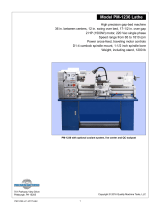 Precision matthews PM-1236 User manual
Precision matthews PM-1236 User manual
-
Grizzly G4003G Owner's manual
-
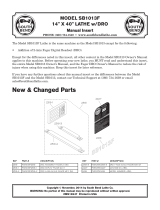 South bend SB1013F Owner's manual
South bend SB1013F Owner's manual
-
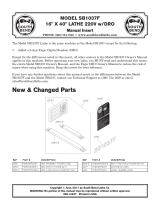 South bend SB1037F Owner's manual
South bend SB1037F Owner's manual
-
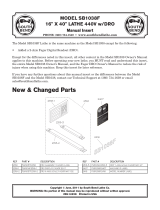 South bend SB1038F Owner's manual
South bend SB1038F Owner's manual
-
Grizzly G0750GV Owner's manual
-
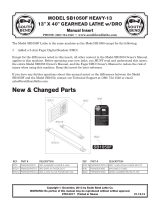 South bend SB1050F Owner's manual
South bend SB1050F Owner's manual
-
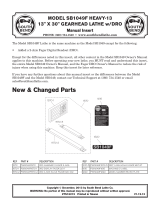 South bend SB1049F Owner's manual
South bend SB1049F Owner's manual





























